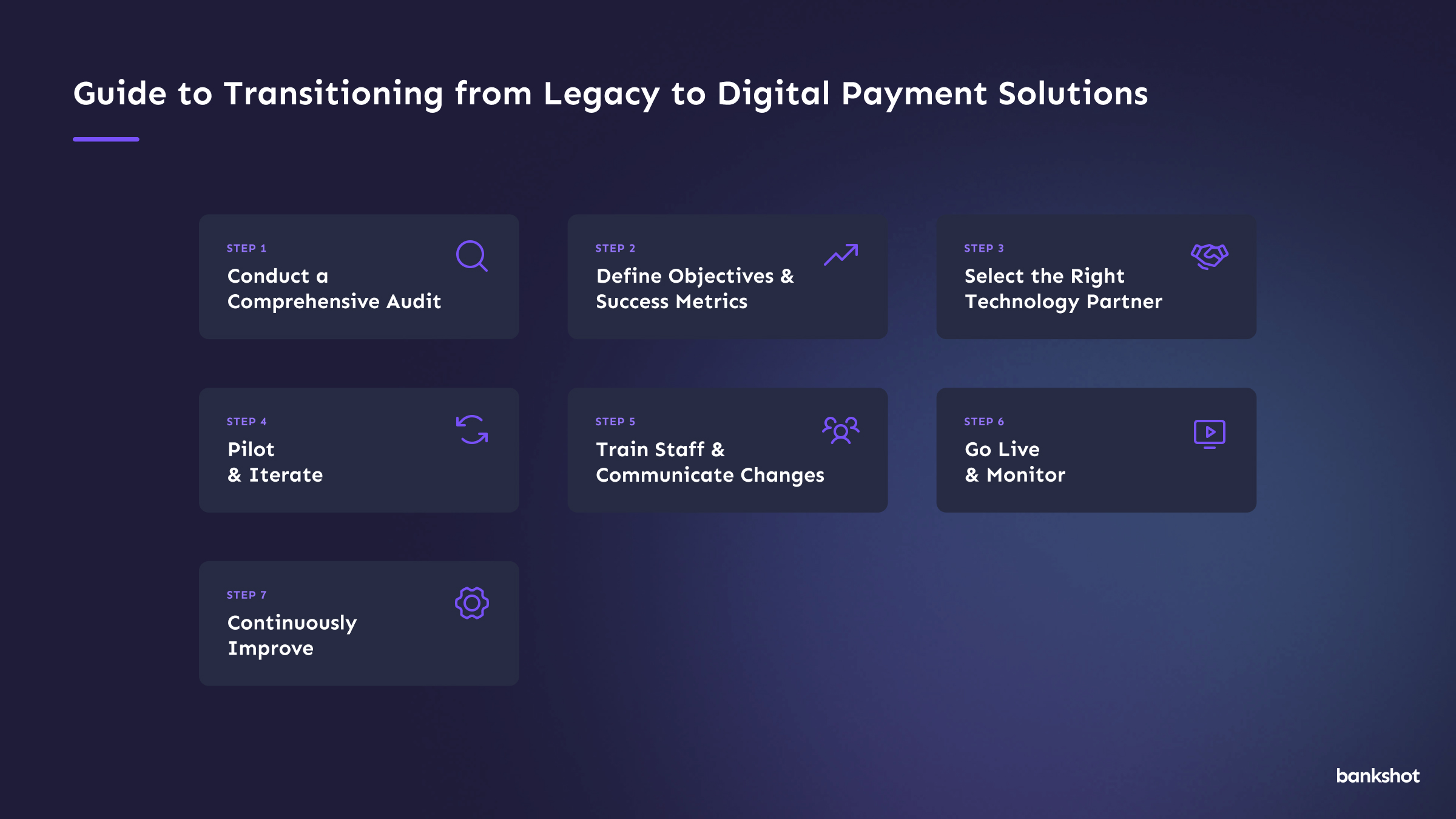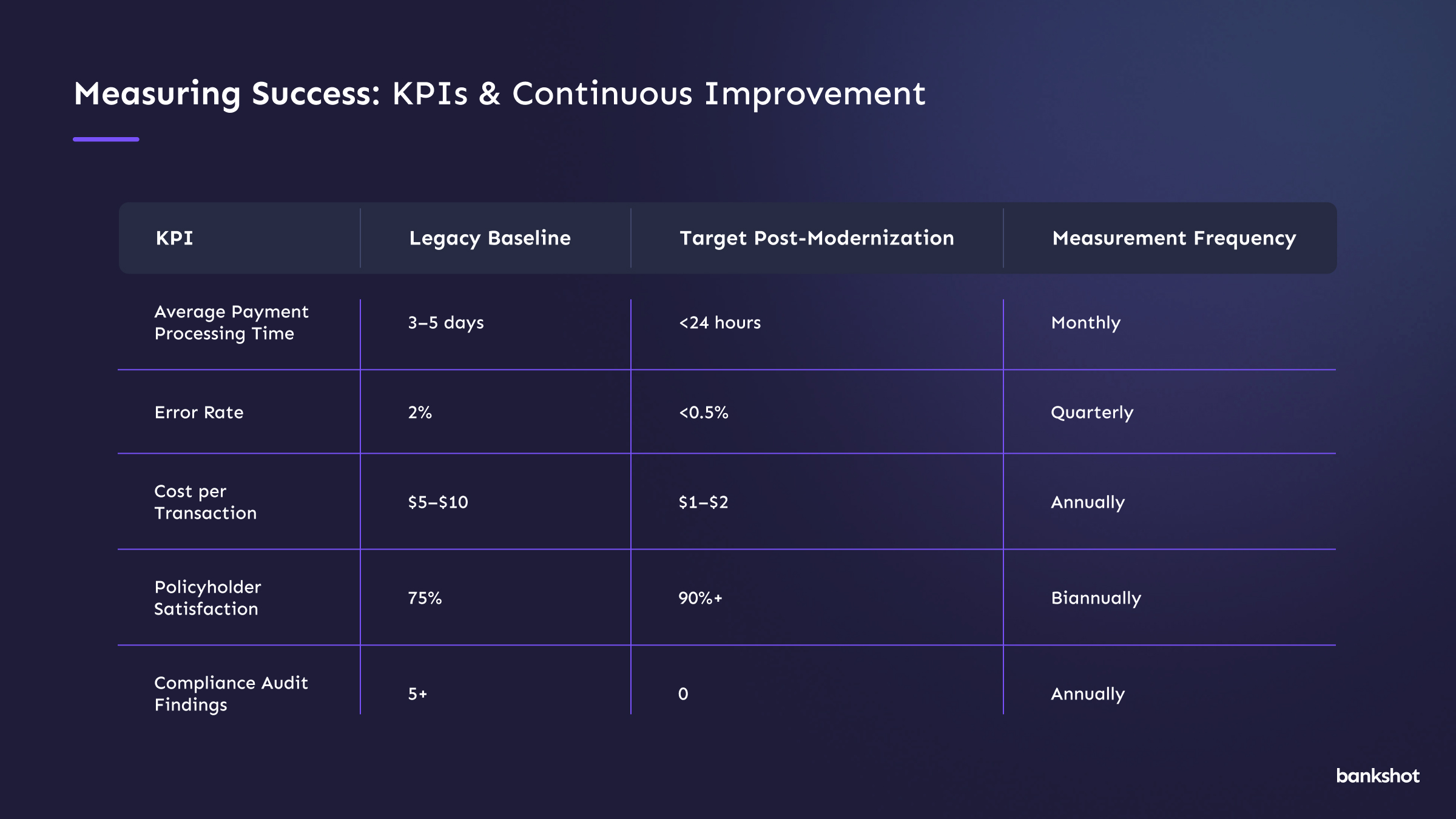.jpg)
Learn how insurers can transition from legacy payment systems to secure, digital solutions. Step-by-step guide, compliance tips, and future trends.

By next year at this time, the insurance industry’s payment landscape will look radically different than it did just a few years ago.
The shift from legacy systems to modern insurance payment solutions is no longer a distant possibility. Instead, it’s an urgent reality for insurers who want to remain competitive, compliant, and customer-focused. The pressure to modernize is coming from all sides: policyholders demand faster, more transparent transactions; regulators are tightening compliance requirements; and new technologies are redefining what’s possible in claims and premium processing. If your organization is still relying on paper checks and batch ACH, now is the moment to take a hard look at your infrastructure—before you’re left behind.
Insurance companies that cling to outdated payment systems are increasingly out of step with market expectations and regulatory demands. Legacy processes—think paper checks, manual reconciliation, and delayed disbursements—introduce friction and risk at every stage of the payment lifecycle. Policyholders now expect the same seamless digital experiences they get from their banks and retailers, and insurers that can’t deliver risk losing business to more agile competitors.
But the stakes go beyond customer satisfaction. Regulatory bodies are raising the bar for data security, fraud prevention, and transparency. Compliance failures can result in hefty fines, reputational damage, and even loss of licensure. Meanwhile, the operational costs of maintaining legacy systems, including manual processing, error correction, and fraud mitigation, are becoming unsustainable as margins tighten across the industry.

This is exactly why services like Bank Shot exist: to help insurers bridge the gap between legacy infrastructure and the demands of a digital-first market. Modern payment platforms don’t just automate transactions; they embed compliance, enhance security, and provide real-time visibility into every dollar.
Before embarking on a modernization journey, it’s ideal to conduct a thorough assessment of your existing payment infrastructure. Start by mapping out your current workflows: How are premiums collected? How are claims paid? What manual steps are involved, and where do bottlenecks most often occur?
Next, evaluate your technology stack. Are your systems integrated, or do they operate in silos? Can they support emerging payment methods like real-time ACH, digital wallets, or account-to-account (A2A) transfers? Finally, audit your compliance posture. Are you meeting all state and federal requirements for data security, anti-money laundering (AML), and funds tracking?
This diagnostic phase will reveal not only pain points but also opportunities for improvement. Common issues include slow processing times, high error rates, limited payment options for policyholders, and fraud vulnerability. Addressing these challenges head-on is the first step toward building a payment ecosystem that’s both resilient and future-ready.
Several powerful trends are accelerating the adoption of modern insurance payment solutions in 2026:
These trends aren’t just theoretical. They’re reflected in the strategic priorities of leading insurers and the expectations of policyholders. Firms that fail to adapt risk falling behind on efficiency and customer satisfaction.
Transitioning to modern insurance payment solutions is a multi-phase process that requires careful planning and execution. Here’s a structured approach:

Like we mentioned before, it’s important to inventory all current payment processes, identify pain points, and assess compliance gaps. Engage stakeholders from finance, IT, compliance, and customer service to get the full picture.
Establish clear goals for your modernization initiative, whether it’s reducing processing time, cutting costs, improving compliance, or enhancing customer experience. Set measurable KPIs to track progress.
Choose a platform that offers flexibility (support for multiple payment types), robust security (SOC 2 certification, daily audits, etc.), and seamless integration with your core systems. Specialized providers like Bank Shot focus on high-value B2B transactions and understand the unique needs of insurers.
Launch a controlled pilot with a subset of transactions or business lines. Gather feedback, measure performance against KPIs, and refine your approach before scaling.
Ensure that employees understand new workflows and tools. Provide training and support to ease the transition and maximize adoption.
Roll out the new system broadly, but continue to monitor performance closely. Be prepared to make adjustments as you learn from real-world usage.
Use analytics to identify further optimization opportunities. Stay attuned to emerging technologies and regulatory changes to keep your payment ecosystem ahead of the curve.
Digital transformation is rarely without hurdles. Some of the most frequent challenges insurers face include:
Addressing these challenges requires a combination of technical expertise, stakeholder engagement, and strategic patience. Partnering with experienced providers can help mitigate risk and accelerate time-to-value.
Compliance is non-negotiable in insurance payments. Modern platforms must adhere to a complex web of state and federal regulations covering data privacy, AML, funds safeguarding, and transaction reporting. Insurers are also under increasing pressure to demonstrate proactive fraud prevention measures as wire fraud and social engineering attacks become more sophisticated.
When evaluating payment solutions, look for:
By embedding compliance into the payment process—rather than treating it as an afterthought—insurers can protect their policyholders and reduce risk.
The true test of any modernization initiative is whether it delivers measurable business value. Key performance indicators (KPIs) for insurance payment solutions might include:

Regularly reviewing these metrics will help you identify areas for further optimization and demonstrate ROI to executive stakeholders.
The pace of innovation in payments shows no sign of slowing. Looking ahead, insurers can expect:
Insurers that embrace these innovations early will be best positioned to meet evolving customer expectations and regulatory requirements.
The transition from legacy to modern insurance payment solutions is not just a technology project; it’s a strategic imperative.
The journey requires careful planning, cross-functional collaboration, and a willingness to challenge long-standing assumptions about how payments “should” work. But for organizations that get it right, the rewards are substantial: faster settlements, happier customers, stronger compliance, and a foundation for future growth.
This is exactly why services like Bank Shot exist—to help insurers navigate this transformation with confidence, security, and speed.
The insurance industry’s payment landscape will undergo a profound transformation in 2026. Legacy systems are giving way to unified digital platforms that offer speed, security, compliance, and flexibility.
The path forward is clear: assess your current infrastructure, define your objectives, select the right technology partner (such as Bank Shot), pilot thoughtfully, train your team, go live with confidence, and continuously improve. Along the way, keep a close eye on KPIs, stay attuned to emerging trends, and never lose sight of the ultimate goal: building a payment ecosystem that’s as resilient as it is customer-centric.
Ready to start your modernization journey? Contact Bank Shot today to learn how our platform can help you transition smoothly from legacy systems to modern insurance payment solutions.
Experience the future of earnest money management and join the growing number of satisfied clients who have already embraced Bank Shot's innovative solutions.
Discover more insights and tips in these related articles.

